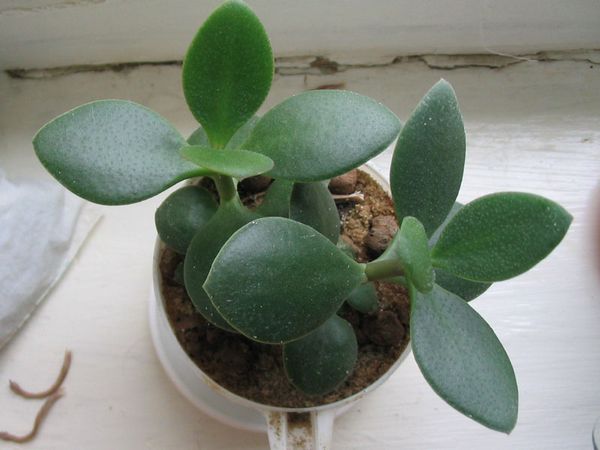
Crassula money tree reproduction. Reproduction of a fat woman by a leaf. Proper plant care
The fat woman, which is also called the money tree, is one of the most common and rather unpretentious indoor plants. But like any other, it needs proper care and good conditions. All indoor flowers need to be repotted from time to time, which can be quite a challenge for certain types of flowers. Let's talk about how to properly transplant and propagate this home flower.
The upper part is cut straight, the lower part is cut obliquely so that it can be distinguished later up and down. Scrub the surfaces with charcoal powder and let dry, with the iris cutting the leaves into thirds. At the top they should be covered with earth.
Casting, coating with glass or foil. Raspberries can also be used for cutting cuttings. Cut out the longer root and cut it into finger-length pieces. Place in planted bed and cover with a little loose soil mixed with compost. All cuttings must have a bud pointing up. Similarly, anemones, mountains, elf flowers, spring poppies and lily of the valley plants are added. It is advisable to press the root cuttings horizontally up to half in the substrate, with the bud up.
Each plant grows, and sooner or later it becomes crowded in the pot or vase in which it is located. Flower well more spacious dishes for normal development. In addition, for a long and healthy life of the plant, it is necessary to enrich the soil.
 cramped pot
cramped pot
Reproduction of a fat woman at home
Crassula or Crassula is a deciduous plant belonging to the genus of succulents of the Crassula family. Its leaves are arranged in pairs and turned to each other by 90 degrees. Even from one such leaf at home, you can grow a whole tree. Can reproduce in two ways: cuttings or rooting of the leaf. Which to choose?
From ancient plants from late summer to winter, one-year branched shoots are cut, about 20 cm long with about 6 buds. The lower one is obliquely cut right under one eye, right above one eye. The tip of the soft disk is then removed. With a shovel into the ground, sting and move it back and forth so that the hole expands. Insert the sticks so that only the topmost belt looks like. In winter, you can place the foil in a similar way.
Many forest plants can also grow in water. Evergreen shrubs can also be reproduced during the winter. They quickly grow and grow outward, dissolve and become independent plants. The onion breaks out after flowering in autumn, and some of the outer brutzwebels are detached. Disinfection of cracks with carbon powder. Cool and dry in the basement. In the summer they sometimes fertilize and bloom well, in the autumn they are usually planted when they are sufficiently grown. Duration at least 1-2 years before flowering. - The snake's snout forms Brussels straw in the inflorescence.
For the first way cutting you need to put it in water for rooting or immediately plant it in prepared soil in a medium-sized container. In both versions, the cuttings easily take root.
This is best done in spring or summer. If the soil is suitable: moist and nutritious, then the plant will quickly begin to grow and give side shoots. In spring or winter, growth will be slower.
They are removed and processed like other bread worms. Thus, the following can be distributed: gladioli, fangs, sticky plants, chandeliers, milk stars, tulips, timeless. Some lilies and daffodils only form a few brutzwei, but they are almost as big. When daffodils become stagnant, many-legged daffodils break down and breed separately. But they must have roots. Dandruff multiplication is preferably performed in imperial crowns and lilies, especially in the case of Madonna lilies and Turkic lilies: after digging, dig out 3-4 outer scales, dust the ulcers with charcoal and replace the onion immediately.
Another way is leaf rooting. With this method of reproduction, such a problem as rotting is often encountered. To avoid it, the leaf must first be dried for two or three days. Only after it has become lethargic should it be partially buried closer to the edge of the pot so that it rests on it. As soil, you can use a composition with a mixture of peat and sand or wet moss. To prevent rotting, it is necessary to avoid waterlogging the soil.
Only the tops of bulb scales can be peeled. This is followed by cold working at 4-8° in a cool basement to stimulate leaf formation. Child onions: Hyacinths, daffodils, and ornamental garlic can be stimulated to form child onions by cutting an onion floor across a clean knife during a rest period and placing a small pebble every quarter. Subsequently dust with charcoal. If the onion plants produce flowering shoots, they are removed immediately to save the plant.
The next year, after removing the leaves, remove the onion, separate the fractions with charcoal and plant the newly obtained onion again. Stratified tubers: Brood tubers form at various points on the mother's tubers, mostly on the underside. Bulbs: First of all, lilies form bulbs in the axes of the leaf. They usually sit on top leaves. In the center of the flask there is a germinal tip, at the lower end there is a small root. The plant then forms a separating tissue, after which the bulbs fall off on their own.
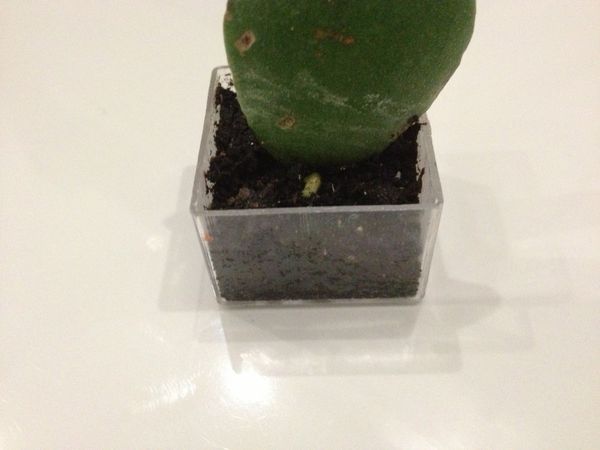 Rooting cuttings
Rooting cuttings Transplanting a money tree at home - how to transplant a flower into another pot in stages
Transplanting a fat woman should be done in the spring, The best time is from April to May. Crassula should be transplanted no more than once every two years, because the tree grows slowly. Although, if, when keeping a flower, it has enough lighting, water and top dressing, it happens that even after a year the pot becomes small. As soon as you find this, start transplanting.
They may be cleared in autumn or even excavated prematurely. They can overwhelm in a cool, dark, slightly damp room. In the fall of the following year, they are grown to a small onion and transplanted as usual. Most of the time they bloom for the first time in a year.
When the bulbs are planted outdoors, they should be protected with spruce rice. They are like bulbs, they are superimposed by small seedlings that are located in the axes of the leaf, For example, leaf broods, fat chicken generators, flaming catechism and quarry. Usually the roots are not trained yet. Therefore, treat with a hormone hormone and place in a growing box. For wintering in the freezer, they are covered with a layer of peat.
How to choose the right soil - good soil composition
Of course, you can just buy a ready-made soil mixture. Or cook it yourself. To do this, you need to take in a ratio of one to one, and to three: soddy land, sand and leafy ground. It is also necessary to add a little clay, ash and humus. Can be used as drainage pebbles, ground brick or expanded clay.
Orchids such as dendrobia and phalaenopsis form small plants from dormant eyes or flower buds. They are cut and placed in special orchid soil. To prevent them from falling, attach them to a stick or wire. Lilies and imperial crowns have scales on their pommel that are suitable for breeding. In autumn, after the foliage has dried, the onion is dug up and no more than six outer scales are wiped off, the wounds are wiped with charcoal, and the dandruff is partially digested into a mixture of garden soil and sand or fertilizer. The uterine onion immediately breaks out again, possibly in a different place.
The ideal option for a money tree pot would be low enough, but wide.
It is necessary for two reasons.
- The fat woman grows best in a not very deep container, since its root system is small in volume and is located in the upper soil ball. Therefore, if the dishes are high, moisture will accumulate on its bottom, which the roots will not reach. Due to waterlogging of the soil, pathogenic flora can develop, and the plant will get sick. Drainage holes at the bottom will help with this problem.
- A rather large width is necessary so that the large crown of the crassula is directly above the moist soil.
Crassula is a tropical plant, so it needs moisture. Do not overdo it with watering!
The balance stays damp and warm at temperatures over 20°. The plastic bag placed above it provides the required humidity. Bright light is undesirable in this phase. The window sill cold should be left with polystyrene or similar measures. After a few months, scaly roots and small onions formed, possibly small leaves. This is the right time when the scales are taken out and planted individually in small pots, only a hint is allowed to peek. The temperature should now be around 5 °. When they are the size of a thumbnail and have formed leaves, they are placed on the bed.
In addition, this shape provides stability to the dishes, which is very important because of the large and heavy crown, which will soon become a decoration of your home. That's why it is better to choose clay or ceramic pot.
After all the preparations, we are engaged in transplantation.
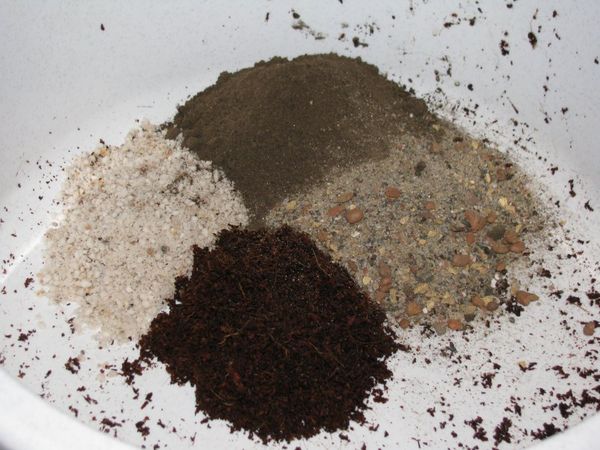
How can you transplant
What further care does the flower need?
After transplanting, the flower needs attention from you. Follow these rules for the fat woman to take root:
This may happen next spring in wide growing varieties, otherwise they will remain in pots. The depth of the plant should be twice the diameter of the flask. It will take several years before flowering. Pastries are ready-made young plants, for example, from Kalanchoe and Tolmie. Take it off and plant it in the soil.
Further reproduction time for different plants. Barberry, cuttings 7-10. Pear, Oculation 7-8, Graft M 2 - M 5. Bitterwurtz, Blattstekling, Fryuling. Leafy leaves, leaf cuttings, spring. Leaf cactus, cuttings, all year round. Flowering buds, leaf cuttings, spring. Blackberry, descending 7-8, cuttings 7-9, root cuttings 10 Christosis, cutting root 2-4, 9 Kristorn, cuttings, all year round. Chrysanthemums, cuttings, 2 thick leaves, leaf cuttings, spring, summer. Eisenhut, division 2-4, 9 rocks, cuttings M 6 - window sheet, cuttings, all year round.
Now we need take good care of your pet. We follow simple rules:
- Do not forget to loosen the soil, to pass air to the roots
- Avoid direct sunlight so that the leaves do not get burned
- We water only when the topsoil is visible dry, so as not to overmoisten it.
- Sometimes spray or wipe the leaves with a damp cloth
- Maintain a moderate temperature
- Early March to October feed once a month special fertilizer for succulents.
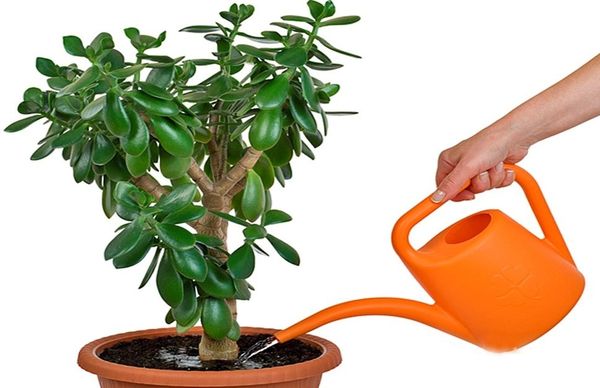
The money tree blooms quite rarely, so careful care can accelerate such a rare phenomenon as white and pink inflorescences on a fat woman.
Greaves, leaf cuttings, spring, summer. Lilies, cuttings Mi 6 - A 8, root spurs 2-4, M 9 fuchsia, cuttings Mi 8 - E cress, cuttings, 9-11, honeysuckle, cuttings 6 Geraniums, cuttings Mi 8 - E golden, step 2-4, 9 Raspberries, dipping 7-8, roots M 10 - M 12, root shoots all year round. Poppies, root crops, spring. Oleander, cuttings, all year round. Wine, cuttings 1 - M 4, 11 fairy nuts, dipping 1-4, 9 steps of decoration, dipping 1-4, 9. Large cut surfaces should always be treated with charcoal powders, which repel infections.
Covering with perforated plastic film leads to faster rooting; don't forget the air. Small pots are generally preferred, if not, offspring on the outer edge, where the strongest vegetative forces are. Their effect can be further improved by placing a small pot in a large one so that the cuttings get stuck on both sides near the edges. Pineapple, avocado, coffee, lychee, mango, papaya, citrus fruits: avocado pods are poured into the soil with the side up and only half of them when growing humus.
The article discusses the main methods of vegetative propagation of Crassula by cuttings and leaves with rooting in a soil mixture or aqueous solution.
The fat woman belongs to succulents. Numerous species are found in many regions of the world as one and perennials herbaceous, bushy and tree-like forms (from 0.3 to 5.0 m). With equal success can be grown in open field and enclosed spaces.
Always pay attention to humid air, and then it needs a lot of water. Light location, 5-12°. - Other seeds are placed at a depth of 8-10 mm in moist butterflies and remain moist. - Seeds germinate faster under moist, warm air. Use a transparent container with a lid. It is filled with a small amount of water and heated up to 25° with a heating element. Avocados or seeds lie in a pot placed in a transparent vessel, but raised on clay pots or stones.
The lid closes the container. Additional germination is created by additional lighting. If the plant is properly cultivated, its small fragrant fruits grow. - Replace after sprouting. This procedure can be repeated several times depending on the growth. Pineapple, Prepare: Using a sharp knife to cut green leaf away from the fruit, remove the bottom leaves. After about five weeks, roots develop, then the film is removed.
Biological features
Crassula or fat woman is popularly called the money tree for the resemblance of leaves to coins. The leaves are simple, round, juicy, shiny, densely cover the stems of a bushy plant. It blooms with small flowers of white, pink, yellowish flowers, collected in small umbrellas. When grown indoors, color is rare, which is associated with a lack of lighting. The root system is powerful, forms aerial roots.
Avocado, prepare: Wash the core of a ripe avocado. Place in warm water, after two days brown brown skin. Place the tipped core in a small glass of water and darken around with aluminum foil, roots after six weeks. Plants: Whether the roots are well formed, the core in plants of flowering plants.
Pomegranates, cook: Remove the kernels, remove the fruit pulp. Put in a glass of warm water, read the two-day swelling. Sowing: Place five to six seeds in a pot. Store at room temperature. The first seedlings after two to three months. Important: a lot of light, but not bright sun.
Care
Fat women are sun-loving. All year round need bright lighting. For normal growth and development in summer, an air temperature of + 12- + 18 * C is sufficient. In winter, during the dormant period, the minimum temperature is + 7 * C. Watering is moderate with a dried top layer (up to 3 cm) of soil. By autumn, watering is reduced and plants are not watered in winter. During the growing season, they like spraying with warm settled water. Top dressing is carried out with special fertilizers for succulent plants.
Mango, prepare: cut the core, peel the fruit pulp. Let dry, use a knife to drill into the pointed end until the core is exposed. The first seedlings after three to four weeks are then fertilized. Papaya, prepare: wash the seed kernels, dry them with kitchen paper, remove the gel protective layer. Put a transparent plastic bag on it, keep it wet. Seedlings after two to four weeks. Great success is guaranteed by seeds as ripe as possible.
In addition, plants need a lot of heat and sufficient humidity - like in the tropics. Propagating succulents is easy and can be a way to keep your vases and garden fresh at all times. Besides having to spend money on buying new juicers, the practice of gardening has its own anti-stress properties.
Crassula are easily propagated vegetatively by cuttings, individual leaf blades and seeds. Reproduction of the fat woman by seeds does not convey the properties of the plant, it is quite difficult to work and is used much less frequently than vegetative.
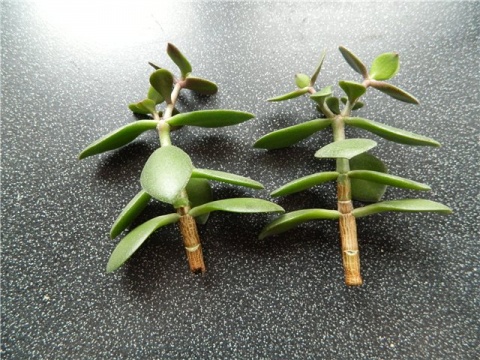
Reproduction by cuttings
For propagation of a fat woman by cuttings, it is necessary:
There are three ways to propagate succulents: through leaves, seeds, and cuttings. The most common method is to use leaves, but it's worth noting that using leaf spread, some succulents are easier to root than others.
Remember to keep the soil moist, but don't let the water fall on the leaves. Within three weeks you will notice the formation of roots and a small rosette will begin to grow. But it's not time for a transplant yet. Transplant only if you notice that the mother's leaf has turned yellow and wrinkled. This means that the new plant has captured the nutrients and is ready to be transplanted.
- inspect the plant and choose a sufficiently developed process 10-12 cm in size,
- carefully separate from the mother plant and leave to dry for a day.
You can root cuttings in 2 ways - in water and in soil.
Rooting cuttings in water:
- on the petiole separated from the mother plant, we cut off the lowest leaves,
- put the prepared stalk aside,
- fill the container halfway with water, add root to accelerate the formation of roots,
- we strengthen the stalk in the container so that it does not “drown”,
- place the container with the handle so that the leaves do not fall under direct sunlight.
After 2-3 weeks, roots appear on the handle. The plant is ready for planting.
Rooting cuttings in soil:
- prepare pots for planting. Wash the old ones with soap and disinfect, soak the new ones in boiling water,
- lay drainage from shards and sand at the bottom of a 7-8 cm pot, fill 0.5 of the pot volume with soil mixture,
- the soil mixture is prepared from clean garden soil and sand in a ratio of 1: 1,
- make a shallow hole in the pot with a pencil and lower the prepared stalk there,
- pour the soil mixture into the pot (you can’t tamp!), not reaching the top edge of 1-2 cm,
- water moderately, gently along the edge of the pot when the top layer of the soil mixture dries out. Excessive moisture causes the death of the cutting.
The next year, the stalk is transplanted to a permanent. During rooting, you can not change the location of the rooted cuttings.
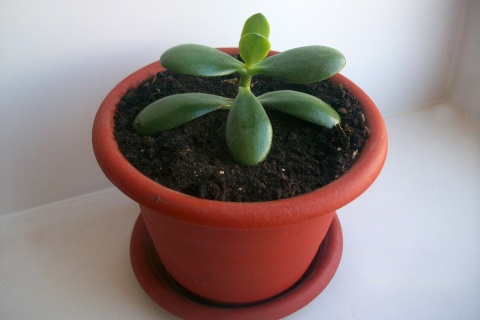
leaf
Reproduction of a fat woman by a leaf, as well as by a cutting, can be carried out in water or soil mixture.
Leaf rooting in water:
- For rooting in water, carefully separate the lower, well-developed leaf of the crassula and leave it for a day in the shade,
- prepare a flat container or vial and immerse the sheet with its lower end in water with 0.5 cm root,
- move to a warm bright place without direct sunlight,
- with the appearance of roots, carefully transplant into a shallow bowl for greater development of the root system, and after a month in a 5-7 cm pot.
Leaf rooting in soil:
- place peat with sand or wet moss in a bowl, moisten with a solution of water with root and prikopat the bottom of the sheet (about 1/3). Do not allow excess water, the leaf will rot,
- cover the dug sheet with a glass, creating greenhouse conditions,
- ventilate the greenhouse several times a day (several minutes, slightly opened),
- spray finely with warm water when the top layer of artificial soil dries,
- support the sheet.
Rooted cuttings and leaves are transplanted into large containers annually during the first 3-4 years.
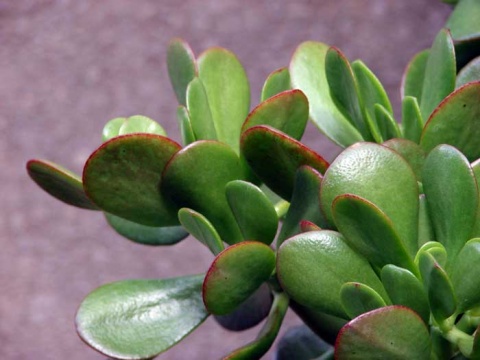
seeds
Crassula propagation by seeds is carried out much less frequently. To obtain an adult plant, propagation of a fat woman by seeds takes a longer period and a greater amount of time for care. Seed propagation is mainly used by breeders to obtain varieties and hybrids and is practically not used at home.
For fans of propagation by seeds at home is carried out as follows:
- washed and disinfected bowls are filled with a soil mixture of leaf earth and sand, respectively 1.0: 0.5 parts,
- Crassula seeds are very small. They are sown on the surface of the soil mixture and sprinkled with sand,
- moisten and cover with glass to create greenhouse conditions with high humidity,
- bowls are aired daily.
- the top layer of soil must remain moist (not wet),
- after 2-3 weeks, shoots of seedlings appear,
- for picking seedlings, a soil mixture is prepared from soddy, leafy soil and sand (respectively 0.5: 1.0: 0.5),
- seedlings dive into bowls with a moist soil mixture and are placed in a well-lit place, but without direct sunlight,
- when reaching 5-7 cm, the picks are transplanted into 5 cm pots with light soil. During the engraftment period, the air temperature is maintained at the level of 15-18*C.
Thus, fat women quite easily and quickly reproduce vegetatively by cuttings and leaves. Rooting cuttings and leaves can be carried out in water or soil mixture. Seed propagation at home is impractical.